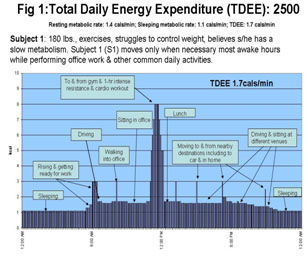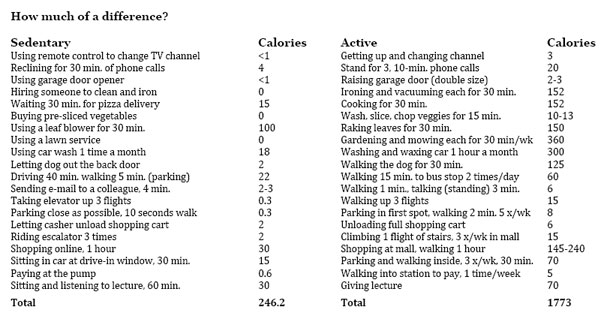Weight control is possible without traditional exercise (though there's no substitute for true exercise).
 Somehow during the last few decades, somewhere between 20 and 40 years of age, you’ve gained about 20 pounds. This didn’t have to happen--if you had walked an average of 150 more steps daily (which takes about three minutes) during a period you would normally have been sitting, chances are you would still have that same 20-year-old body. If only you’d paced around your office or home while you were on a three-minute phone call, or walked around your house once daily. If you had gone to the gym only ten times each year for approximately half an hour, engaging in a light workout, you would be 20 pounds lighter. And that’s without changing what you ate and drank during those 20 years!
Somehow during the last few decades, somewhere between 20 and 40 years of age, you’ve gained about 20 pounds. This didn’t have to happen--if you had walked an average of 150 more steps daily (which takes about three minutes) during a period you would normally have been sitting, chances are you would still have that same 20-year-old body. If only you’d paced around your office or home while you were on a three-minute phone call, or walked around your house once daily. If you had gone to the gym only ten times each year for approximately half an hour, engaging in a light workout, you would be 20 pounds lighter. And that’s without changing what you ate and drank during those 20 years!
Now, imagine you gained 40 pounds during the last 20 years. Simply double the above numbers and picture yourself 40 pounds lighter. You get the picture. Most people don’t gain weight because they are slothful creatures. Instead, slow, steady weight gain creeps up on us. Many people arrive at a point where they feel it’s too late, the damage is done, it’s too hard to lose weight or they don’t have enough time in their busy lives to make changes.
Take it up a notch
If you need to lose weight and don’t want it to take the 20 years it took to put it on—but at the same time you fall into that category of “no time” or “can’t stick to a diet”—use the formula above and accelerate it up to the point where you can erase the weight over the next year. Like the sound of losing weight without working out and dieting? Basically, you can consume the same foods and fluids but simply move more within your normal daily activities. Here is an example of what a 175 pound person, who does not wish to change his/her lifestyle and eating habits, can do to lose 20 pounds. Refer to “Your Life is Exercise” for additional calorie burning tips.
Start here
Put a stop to the instinctual habit that tells you to take the path of least resistance, the easy way out. Instead, choose to take the path of more resistance anytime you can. In other words, anywhere you can squeeze in some extra steps or movement, do it. Park further out from your destination, pace or stand at home or in the office while on the phone, reading or simply talking to someone. Think “why sit when I can walk or stand”? Get a pedometer and find out how many steps a day you are currently walking. Gradually add an extra 500 steps to your day until you are regularly averaging 2500 steps more per day than you were prior to reading this article. Maintain your same basic lifestyle and eating habits, but incorporate the “move when you can” attitude and stand or pace when performing tasks you previously would have done sitting down. You don’t have to do all this at once; break it up any way you want to. Just average an extra 2500 steps daily. For current physical activity guidelines, click here.
A little goes a long way
For a 175 pound person, every ten minutes of normal walking or pacing while doing something equates to burning approximately 20-30 more calories than sitting down doing the same activity. So, by moving upright for one hour (about 2500 slow steps) more than before, you will lose about 1.5 pounds per month or 18 pounds over the course of a year without working out in a gym (as long as your food intake doesn’t increase). If you did add gym time and a slight reduction in your food intake as well, you could lose significantly more. Not so daunting of a task anymore, is it?
Note: the lighter you get, the fewer calories your body burns, so for every 5-7 pounds you lose, you should add about 500 more steps per day if you choose not to slightly reduce or alter your food intake. Continue the process until you achieve your goal weight.
Tips for extra movement in the gym
Use the same tips recommended in the “your life is exercise” section, but use them in the gym or while going to the gym.
- Park your car in a safe place at least 1250 paces from the gym
- Always pace or stand between sets
- Circuit train (i.e., move from one exercise to another with little to no rest but rotating body parts)
- Get all 2500 steps/day using cardio machines. On non-workout days, follow the daily life tips or simply do more steps during the three days you are in the gym using a treadmill, stepper, etc., to make the weekly total.
Bottom line
Everyone sits at least an hour a day; the vast majority of people sit a minimum of eight. Find the parts of the day when you can stand, sit or pace while performing something you would normally do sitting down. No matter what you do or how, just be sure you have added an average of 2500 steps to your daily routine and as you lose weight, slowly increase your steps. Always remember, every calorie counts, in or out. That’s a scientific fact. Remember this: if you are wearing it, you ate it.
So there you have it, the easiest, least painful method to stop or reverse weight gain. This is something anyone can do and—most importantly—maintain.
Your Life is Exercise
Around the House
- Get a cordless phone if you do not have one. Walk around the house or yard while you chat.
- Put away the remote control a few days a week and change channels on the TV itself.
- Forget the car wash! Do it yourself and burn about 200 cal.
- Cut back on your cleaning service; schedule them less frequently to save money and boost your activity.
- During commercial breaks on television: Unload one level of the dishwasher. Put in or take out one load of laundry. Clean out one shelf in the refrigerator. Clean out what’s fallen under the sofa cushions. Take out the trash.
- Put away laundry in smaller loads. You’ll make a few extra trips to burn some extra calories.
Traveling
- When traveling by air, walk around the airport till boarding time.
- Walk rather than using moving sidewalks.
- Walk to the airport gate or parking lot instead of using a shuttle.
- Walk to nearby restaurants rather than dining in the hotel.
Errands on the Run
- Bypass the drive through. Use walk-up options at the bank, pharmacy, cleaners, etc. Park at the back of the lot and walk.
- Carry smaller loads into the house to make a few extra trips.
- Hit the mall instead of the Internet.
- Take a lap of the mall or grocery store before starting to shop.
- When loading your purchases, park the shopping cart at the front of the car and carry the bags to the trunk.
- Offer to run errands for an elderly or ill neighbor or friend.
At the Office
- Take the stairs instead of the elevator.
- Get off the elevator two floors early—walk the rest of the way.
- Park a couple of blocks away from your office and walk.
- Use the restroom or coffee maker farthest from your office.
- Use a smaller water bottle and coffee cup. You’ll get up for refills more often.
- Take regular breaks and walk once around the office building.
- Walk to lunch instead of ordering it.
- Sit on a fitness ball instead of a chair. You’ll burn more calories and strengthen those abs.
- Waiting for copies? Take a quick walk while the copier finishes your job.
- Don’t eat at your desk. Take a walk, eat in a nearby park, or climb a few flights of stairs.
- Visit people’s offices instead of calling or e-mailing them.
- Walk the entire office a couple times/day. Visit departments you don’t normally deal with.
- Start an office walking club. You can meet before or after work or even at lunch.
Do these things really add up and make a difference? Refer to the two figures below. They illustrate the impact adding daily movement can have on the same person. All of these “little” tweaks to your daily activity have a significantly greater impact than the daily exercise session. Now, if you did both you’d be golden!


